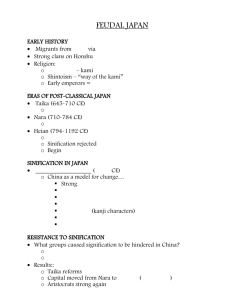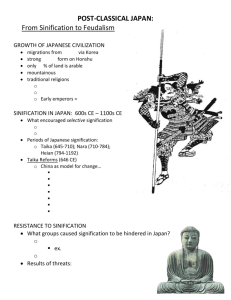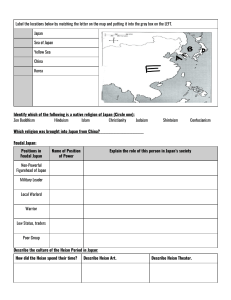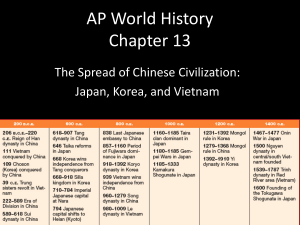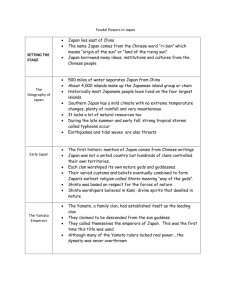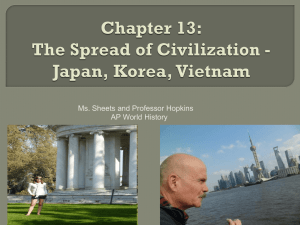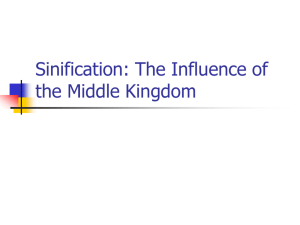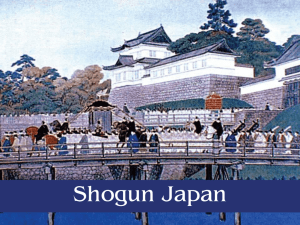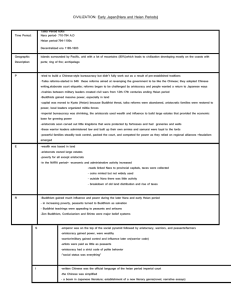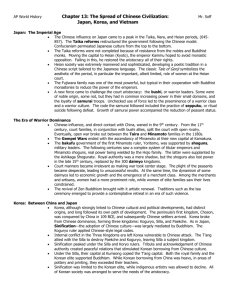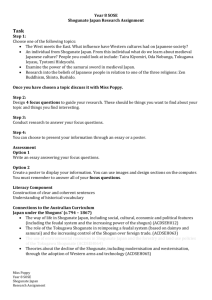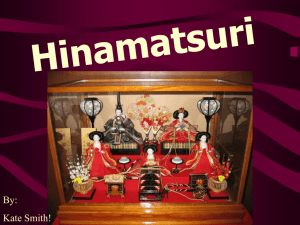Chapter 13 - Ms. Sheets` AP World History Class
advertisement
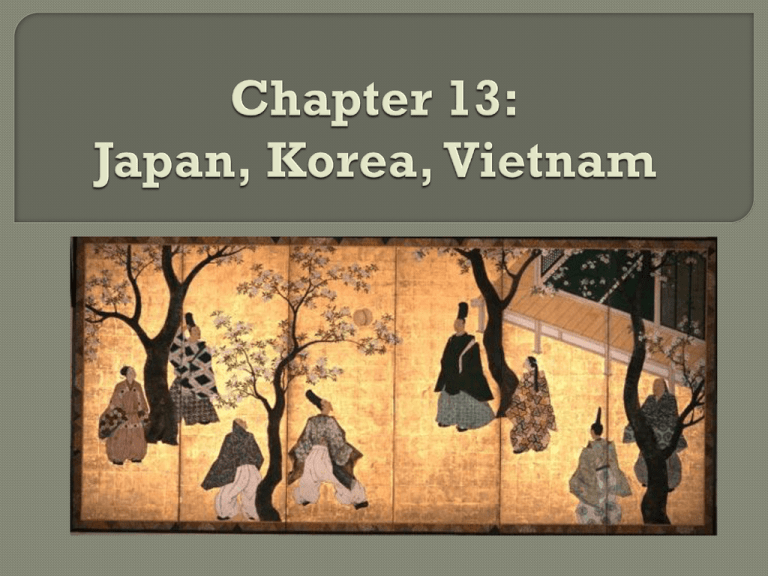
Japan’s Imperial Age • 5th c: Yamato clan emerged as emperors • 6th -7th c.: Chinese culture increasingly influences Japan • Taika, Nara, and Heian periods (7th to 9th centuries) • Tremendous borrowing from China (Sinification) • 645 CE: Taika Reforms • Copy Chinese style of rule in Japanese government • Try to develop bureaucracy to limit power of aristocracy; opposed by aristocracy • Confucianism rejected; Japan held birth in esteem, not education Heian Period • 794: Capital moved from Nara to Heian (later Kyoto) • Chinese influence declined • 838: Japanese embassies to Tang China stopped • Taika reforms abandoned • Power of aristocratic families increases (Fujiwara) Court Life in the Heian Era • Extremely refined; based upon codes of behavior • Aesthetic enjoyment • Literary Golden Age: poetry, love notes, stories • Women and men take part in literary production • Lady Murasaki’s Tale of Genji • Growing isolation of the court provided opportunities for regional lords with a more military orientation to seize effective control of Japan. What were the Taika Reforms? How would you describe the Heian Era? Increase of Powerful Families • Fujiwara, Taira, Minamoto • Aristocrats begin to rebel against Chinese influence in imperial government • Aristocratic families begin to dominate government and shape policies through the accumulation of their own armies and large estates • Many aristocrats become bushi (regional war-lords) who administer these territories and armies • Aristocrats marry into imperial family to control policy • Cooperate with Buddhists and Creation of Feudal Japan • Regional lords (bushi) administer small kingdoms, collect taxes, and build up private militaries • Samurai (armed military troops) begin as loyal warriors to bushi • Martial arts esteemed • Code of Bushido stresses family honor and ritual suicide (seppuku) rather than defeat • Serfs (peasants) lose status and freedom, and are treated as property of local lord • Turn to salvationist Buddhism (live morally pure lives on Earth) Decline of Imperial Power and Creation of Shogunate • Japanese feudalism means emperor’s power declines • By 11th/12th c., aristocratic families dominate and are in control at court • Kamakura Period (1185-1336) • 1180-1185: Gempei Wars • Taira vs. Minamoto families over political control of Japan • Minamoto victorious control court • Kamakura Shogunate (1192-1333): Minamoto establish Bakufu (military government) headed by a shogun (military leader) • Emperor and court remain; Minamoto family and samurai have real control in shogunate • Ashikaga Shogunate (1336-1573): collapse of centralized authority as emperor flees upon his refusal to recognize Japanese Feudalism Chaos Continues in Ashikaga Shogunate • Power of emperor and shogunate weakens through rebellions, civil war, lack of support, etc. • 14th c: Period of civil war between aristocratic families • Bushi vassals acquire more land • Land then divided among samurai upon pledging loyalty to vassals to give military assistance when needed • 1467-1477: Court rebellions continue, and Japan fragments into 300 small kingdoms led by warlords called daimyos • Japan moves towards greater organization • Taxes are collected to fund public works projects (irrigation; roads) Describe the Japanese feudal system. What are the groups that comprise it? Describe how the shogun relates to Japanese feudalism. Violence in Feudal Japan • Bushido era deteriorates; era of barbarism emerges • Military division, social change, peasant violence • Warfare becomes more brutal • Battles determined more by size and organization of warlord’s forces than the outcome of ritualized samurai combat • Poorly trained peasant armies • Construction of castles Feudal Europe vs. Feudal Japan • Similar: • political structure, social structure, code of honor • Difference: • Europe: simply a land-for-loyalty exchange • Japan: based upon group/family identity and loyalty • Cultural influences (Christianity vs. Buddhism) Economy and Culture • Economic growth is result of daimyo interest in trade, esp. with China • Development of standardized currency • Increase in guilds • Shinto + Zen Buddhism exist simultaneously • Art is stylistically simple • Mimic monochrome Chinese style • Ink sketches • Screen and scroll paintings • Show natural beauty of Japan • Landscapes with tiny human figures • Development of tea ceremonies and Zen Buddhist gardens Korea • Three Ancient Kingdoms: Koguryo, Paekche, Silla • Sinification (adoption of / interest in Chinese culture) • Increases after Han Dynasty (cities, schools, writing, law code, and court organized like Chinese) • Koreans welcome Chinese influence • Power of aristocracy prevents total adoption of Confucianism • Buddhist art, monasteries • 668: Tang Dynasty conquers Korea; now a tribute state • 1231: Mongol invasion, followed by turmoil • 1392: Yi dynasty founded, lasts until 1910 Vietnam • When Tang armies invade, Viets actively resisted them. • Eventually Vietnam is made a tribute state • Sinification is forced upon Viets: Confucianism, government structure, contact through trade • Culture of anti-Chinese resistance develops • Resistance from aristocracy, peasants, women • Distance from China aids resistance efforts • Independence by 939 • Rivalries in native Vietnamese ruling families until 19th century will leave Vietnamese oblivious to outside threats: Describe Korea’s attitude towards sinification. Describe Vietnam’s attitude.
